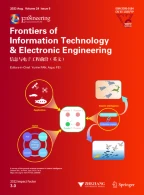摘要
自1957年第一颗人造卫星发射以来, 日益增加的人类太空活动导致空间环境不断恶化。地球轨道上出现大量微小空间碎片(毫米到微米级), 其超高速撞击会对航天器的结构和功能单元, 如舱室外表面、热障材料、热控涂层、太阳能电池板、管道、电缆等, 造成严重破坏。因此, 对空间碎片造成的撞击损伤进行探测和评估, 提供风险预警和及时修复是保证航天器安全运行和空间任务顺利完成的重要环节。然而, 由于航天器外表面材料的复杂性以及撞击损伤事件的不可预测性, 采集的损伤检测数据呈现多样性特点。传统的基于人们经验的损伤特征提取与识别评估方法难以准确描述复杂损伤特征信息。近年来, 人工智能技术受到相关学者及工程技术人员广泛关注, 在解决诸如空间碎片撞击感知、损伤检测、风险评估等复杂技术问题上取得一系列突破。然而, 应用人工智能技术解决空间碎片问题仍有许多难题需要解决。在此背景下, 利用人工智能方法进行航天器损伤检测和评估显现出以下几个重要趋势:
-
1.
运用并结合多种人工智能学习算法(如神经网络与深度学习), 实现航天器复杂损伤检测与特征分类。 人工智能学习算法具有多样性的算法架构, 不同学习算法擅长解决不同问题。结合不同应用场景下的多种人工智能学习算法, 可有效提高航天器复杂撞击损伤检测效率和损伤特征分类效果。
-
2.
改进和优化学习算法, 更准确有效地进行损伤模式识别和评估。
为提高学习算法性能, 优化与改进是必不可少的环节。对算法本身的优化与改进, 包括损失函数设置、迭代步骤优化、终止条件判断等, 可对学习算法的性能产生重大影响。此外, 复杂学习算法网络本身拥有大量需要优化的参数, 网络参数的优化方法已成为决定学习算法性能的核心因素之一。
-
3.
扩展人工智能学习算法和模型, 更好地适应航天器损伤检测与评估系统。
结合具体的航天器损伤检测与评估系统, 扩展现有学习算法和模型, 包括对实际输入的测试数据进行预处理以获得更好的迭代算法计算结果, 对不同损伤检测场景进行分类, 使用不同优化模块以获得更好的性能对比测试, 以及依据损伤评估输出结果划定合理分类标准。
-
4.
利用人工智能技术分析典型航天器撞击损伤样本的数据特征, 指导航天器空间碎片防护设计。@人工智能技术的优势在于可从大量数据样本中提取典型特征。基于在轨空间碎片环境试验和地面模拟试验的大量损伤样本, 人工智能技术可表征不同撞击条件下航天器损伤特征差异, 建立撞击条件与损伤结果之间的联系。因此, 工程师可通过优化航天器的防护结构提高航天器在轨运行的安全性。
-
5.
利用人工智能技术对空间碎片环境建模和分析, 实现空间碎片的监测、预警、减缓和清除, 以减轻空间碎片对航天器的影响。
利用人工智能技术对空间碎片建模和分析, 能描述复杂的、难以用数学公式描述的定性经验知识, 具有较强表达能力。人工智能建模可根据对空间碎片模型知识的新领悟进行修改和扩展, 系统可以更加灵活地适应新的需求。对空间碎片的建模和分析越清晰, 对碎片影响的监测、预警、减缓和消除就越准确, 从而大大降低空间碎片对在轨航天器的影响。 总之, 基于人工智能的航天器损伤检测识别和空间碎片风险评估对于航天工业的发展至关重要, 这些挑战需要航天装备研究、模式识别和人工智能等领域工作者的不断努力。
在此背景下, 《信息与电子工程前沿(英文)》期刊组织了“人工智能在空间环境和航天器中的应用”专题。主要内容关于利用人工智能方法学习检测数据, 以及对航天器进行损伤检测与损伤评估的方法, 包括航天器损伤特征与检测数据之间的层次关联性和如何利用人工智能分析数据对航天器进行损伤评估。经严格审查, 选用了5篇研究论文。
Article PDF
Avoid common mistakes on your manuscript.
Author information
Authors and Affiliations
Corresponding author
Additional information
Weimin BAO is an academician of the Chinese Academy of Sciences (CAS) and the International Academy of Astronautics (IAA). He is currently director of the Science and Technology Committee of China Aerospace Science and Technology Corporation, a vice chairman of the 10th China Association for Science and Technology, a member of the Bureau of CAS and the Bureau of IAA, chairman of the Engineering Department of CAS, president of the Chinese Society of Inertial Technology, and dean of the School of Aerospace Science and Technology, Xidian University. He is an academic pacesetter in the field of general and control systems for space launch vehicles in China. He has won the National Award for Progress in Science and Technology (one outstanding and one first-class) and a first-class National Award for Technological Invention.
Chun YIN received her PhD degree from the University of Electronic Science and Technology of China (UESTC) in 2014. She has been a professor of School of Automation Engineering, UESTC since August 2019. She was an associate professor at the School of Automation Engineering, UESTC, from July 2014 to July 2019.
One of her papers has been included in the Top 5 list of Highly Cited Research during 2013–2016 in J Mechatron, and one of her papers has been included in the ScienceDirect Top 25 list of Most Download Articles in 2012. She received the Overall Best Paper Award in 2015 IEEE International Instrumentation and Measurement Technology Conference. She serves as a corresponding expert for Front Inform Technol Electron Eng. One of her technological achievements obtained the first-class Scientific and Technological Progress Award of Sichuan Province, China. Her research interests include extremum seeking control, multi-objective optimization, infrared thermography testing, and hypervelocity impact engineering.
Xuegang HUANG received his BS degree from Southwest Jiaotong University, China, and his MS and PhD degrees from Mechanical Engineering College, China in 2010 and 2014, respectively. He has been working as an associate research fellow at the Hypervelocity Aerodynamics Institute, China Aerodynamics Research and Development Center since 2014.
His master thesis was selected as one of the Excellent Master Theses of Hebei Province, China in 2012, and his doctoral dissertation was selected as one of the National Excellent Doctoral Dissertations of China in 2017. He has published over 60 refereed journal papers. His research interests include spacecraft measurement and control technology, space shielding engineering, hypervelocity impact engineering, and material dynamic behavior.
Wei YI received his BE and PhD degrees in 2006 and 2012, respectively, both in electronic engineering from UESTC. From 2010 to 2012 he was a visiting student at the Melbourne Systems Laboratory, University of Melbourne, Australia. He was a senior lecturer from 2013 to 2015, and was promoted as an associate professor from 2015 at the School of Information and Communication Engineering, UESTC.
He was the “Best Student Paper Competition-First Place Winner” at the 2012 IEEE Radar Conference, Atlanta, USA, received the “Best Student Paper Award” at the 15th International Conference on Information Fusion, Singapore, 2012, and was a co-recipient of the “Best Student Paper Award” at the 21st International Conference on Information Fusion, Cambridge, UK, 2018. He is an editorial board member of J Radars and a guest editor of MDPI Sensors. He also serves as a corresponding expert for Front Inform Technol Electron Eng. He served as an organizing co-chair, general co-chair, and publication co-chair of ICCAIS 2018, 2019, and 2020, respectively. His research interests include object and signal detection and tracking, radar signal processing, multi-sensor information fusion, and resources management.
Sara DADRAS received her BS degree from Shiraz University, Iran in 2006, and her MS and PhD degrees from Tarbiat Modares University, Iran in 2008 and 2012, respectively, all in electrical engineering. She joined the Electrical and Computer Engineering Department, Utah State University, USA in 2012 as a research fellow.
She is one of the organizers for the SAE Electronics Technical Committee. Currently, she serves as an associate editor for IEEE Trans Autom Sci Eng, IEEE Access, and Asian J Contr. She is a member of IEEE, ASME, and SAE. Her research interests include hybrid electric vehicles, autonomous vehicles, renewable energy systems, image processing, and optimal control.
Rights and permissions
About this article
Cite this article
Bao, W., Yin, C., Huang, X. et al. Artificial intelligence in impact damage evaluation of space debris for spacecraft. Front Inform Technol Electron Eng 23, 511–514 (2022). https://doi.org/10.1631/FITEE.2220000
Published:
Issue Date:
DOI: https://doi.org/10.1631/FITEE.2220000
